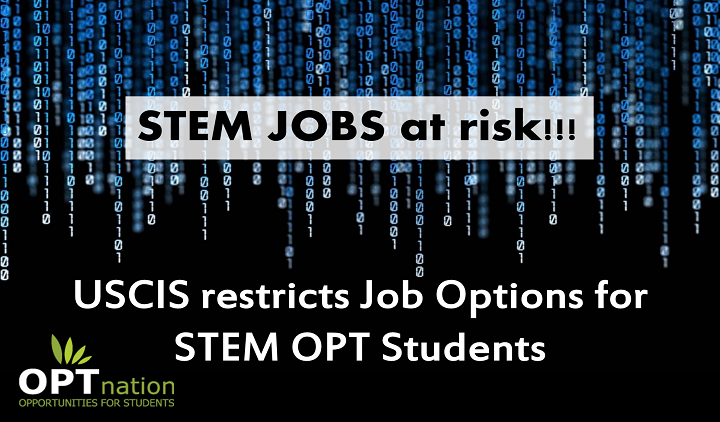USCIS restricts third party worksite Placement of STEM OPT Students
USCIS restricts third party worksite Placement of STEM OPT Students. After the recent restrictions imposed on H1B Visa which allows OPT students to work in USA. The USCIS has introduced a new policy which would affect the F1 OPT or the OPT student visa. The new policy limits the OPT or Optional Practical Training extension for STEM. Earlier OPT students who opted for STEM courses could get an extension of 24 months after the initial OPT. However, the new policy would limit the same.
The United States Citizenship and Immigration Services (USCIS), has recently set out extensive explanations on its. Website as to what constitutes a bonfire OPT employer-employee relationship and on an OPT employer’s obligations. The new policy now changed the interpretation of employer’s obligations by the USCIS, as mentioned on their website. The changes now implicate that the OPT students cannot work at the OPT employer’s client sites. With these restrictions, the students would find it difficult to be hired by tech companies or even business consultancies. STEM courses are the largest group of subjects chosen by students who wish to study in USA.
Optional Practical Training, OPT is temporary-basis employment for International students having an F1 visa, eligible for a 12 month. OPT period under which they can work in the US in a job which is directly related to the major study area of a student. Those, who have completed their degrees in science, technology, engineering and mathematics (STEM) are eligible to apply for a further STEM OPT extension of 24 months. STEM OPT students under the OPT are often recruited by consulting companies in the technology or business management sectors.
Implications of the new OPT Extension Policy for OPT Students in USA
With the new policy introduced, the students who are either planning to or already studying in USA for STEM or Science, Technology, Engineering and Mathematics courses would be directly affected.
The recent update by USCIS is applicable to the STEM OPT extensions. Several international STEM students hoping to work in the United States (US) for a longer duration. Suddenly find their wings clipped, owing to an interpretation of employers obligations by US immigration agency. Their training experience can now only be in-house at the employer’s own work site. That means the STEM OPT students can only work direct for employer and not allowed to work as on client side or third party employers. Which will dent opportunities to work for tech or business consultancies.
You can check out:
-
Full Time Opportunities For OPT Students
-
Career Opportunities for Entry Level Engineering OPT Jobs in USA
-
OPT Students Database in USA
The new policy’s interpretation has however left many students in confusion. USCIS in its guidelines relating to ‘The employer’s training obligations’ mentions that – “The training experience must take place onsite at the employer’s place of business or worksites to which US Immigration and Customs Enforcement. ICE has authority to conduct site visits to ensure the OPT requirements are being fulfill.” It states further that “The training experience may not take place at the place of business or worksite of the OPT employer’s clients or customers because ICE would lack authority to visit such sites.”
The recent explanations by USCIS apply to the STEM OPT extensions. USCIS has spelled out that such students cannot work at the employer’s client sites, which will make it difficult for students to find suitable employers. Going a step further, many students after finishing their OPT under an F-1 visa status obtain an H-1B sponsorship, and if they get an H-1B visa they continue working in the US. Now, even their future prospects can be hamper.
Further, employers who permitted those under an OPT program to work remotely will no longer be able to do so. USCIS explains: “The employer may not fulfil its training obligation to provide a structured and guided work-based learning experience by having the student make periodic visits to the employer’s place of business to receive training, while the student is actually working at the place of business or worksite of a client or customer of the employer. For the same reason, online or distance learning arrangements will not be use to fulfil the OPT employer’s training obligation to the OPT student.”
worksite Placement of STEM OPT Students
The personnel who may provide and supervise the training experience may be either employees of the employer. Or contractors who the employer has retained to provide services to the employer. They cannot be employees or contractors of the employer’s clients or customers. Again, the employer that signs the Form I-983 must be the same entity that provides the practical training experience to the student, utilizing its own personnel,” adds the USCIS.’
STEM OPT always asked for a formal training programs. Which confirmed the OPT employer’s commitments. Both the OPT employer and the OPT student will require to sign Form 1-982. However, until now, the fact that the OPT students cannot work at a client site was not clearly specified. The USA is already seeing a drop in the number of international OPT students. For example, lesser OPT students applied during the year-long period ending September 30, 2017. Only 47,302 student visas were issued during this period as compared to 65,257 visas in the earlier twelve months, meaning a drop of 27%. If OPT opportunities drop, the motivation to study in the US may decline further.
If OPT opportunities narrow down, the incentive to study in the US may drop further.

